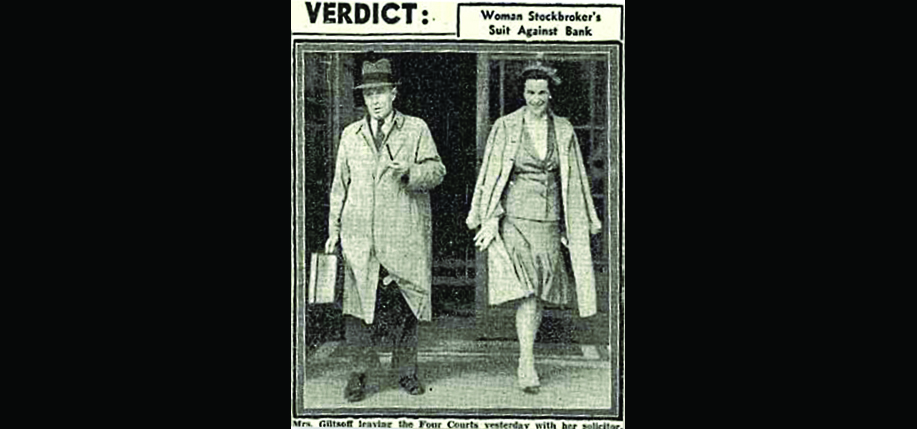On paper, the 1916 Proclamation and the 1922 Constitution of the Irish Free State appeared to signal a new beginning in regards to equal opportunities for Irish men and women. However, the socio-political landscape of 1920s Ireland remained one of restriction for women. Religated to roles as housewives and mothers excluded from employment within the public sphere, any gains made by women in the changing political environment of the time were ultimately constricted by the colluding forces of the new Free State government and the Roman Catholic Church.
And yet it was an anti-discriminatory provision of the Irish Free State Constitution that allowed one woman, Oonagh Keogh, to become the first female member of the Irish Stock Exchange (ISE) and the first woman worldwide to join a stock exchange. Article 3 of the 1922 Free State Constitution guaranteed equality and opportunity to all Irish citizens over the age of 21, so Oonagh’s application could not be revoked on the basis of gender alone.
Born Oonagh Mary Irene Keogh in 1903, in the family home on Shrewsbury Road in Dublin, her successful application was all the more remarkable when one takes into consideration that the first inclusion of a woman to the New York Stock Exchange occurred in 1967 and in London in 1973.
In an interview with the London Times in 1956 detailing her admittance to the Dublin Stock Exchange, Oonagh Keogh herself notes how her application created “consternation and sensation.” Kevin O’Higgins, Minister for Justice at the time, is quoted in the Dail debates of February 23, 1927 as saying, “It is the normal and natural function of women to have children. It is the normal and natural function of women to have charge of households.” This was the type of mindset that Oonagh was up against. Those who oversaw her application soon found, however, that she held all the necessary prerequisites to allow for her admission to the exchange.
Her father, Joseph Keogh, was a long-established member of the stock exchange and thus Oonagh had been immersed in the industry from an early age, giving her something of a head start. That she had had access to private fee-paying education was also certainly to her advantage. From the ages of 11 to 13, she was educated at St. Mary’s Priory, Warwickshire, an exclusive English Roman Catholic convent boarding school for girls. From 1917 to 1918 she attended Alexandra College. She also studied for one term at the Metropolitan School of Art, now the National College of Art and Design.
It was whilst studying in London that Oonagh tendered her application to join the Dublin Stock Exchange. After three weeks of deliberation by members of the Exchange she was admitted at the age of 22. Such a notable achievement at a young age may be comparable to her father’s, who became the youngest ever bank manager in Ireland in the late 1880s, when he took over the running of Hibernian’s bank branch in Swinford, Co. Mayo before he turned 25.
When Oonagh first began working at the Exchange, she joined Joseph Keogh and Co. Stockbroking, working for her father behind his desk and somewhat behind the scenes. However, when he fell ill it became clear that Oonagh was extremely capable at managing on her own, to the extent that clients of her fathers did not realize that his daughter had taken charge in his absence. Business had gone on “as well as ever” according to the aforementioned interview in the London Times. Male colleagues, who had previously declared their intentions of ignoring her on the floor, quickly realized her talents, offering her help when it was needed, in such instances for example when her voice would not carry across the trading floor.
Keogh resigned from the Dublin Stock Exchange in 1939. She had become increasingly frustrated with the patriarchal nature of her working environment where she was never joined by another woman during her tenure and also wished to concentrate on raising her children. She married Russian artist Bayan Giltsoff in 1933, with whom she had four children, Tatiana, Rurik, Nicholi, and Bayan Jr. The couple began their married life in Taunton, Somerset, England, moved back to Ireland in 1947, and to Canada for a short while before returning to England in 1953. They subsequently separated in the late 1950s, sparking a move to Spain for Oonagh where she lived until her final return to Ireland in 1980.
Keogh died on July 18, 1989 at the age of 86. Although her name may not be widely recognized today, she undoubtedly created a space for the inclusion of women in the public sphere, in a particularly male-dominated Irish society at the time.
In a tribute to his mother as part of detailed research undertaken and published by the ISE, her son, Bayan Jr. describes her:
“She always saw the positive in life and was always ready with her good humor and practical attitude towards life in general and to fight against all odds.” ♦


The suburbs of Auckland have been utilized to lend the film a
“Denver, Colorado type feel”.